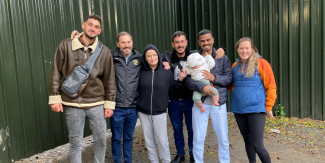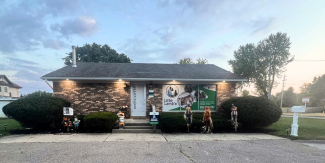August 22, 2019 · TEANNA SUNBERG
Lilly* and Rafael are refugees, though they did not come to Europe on boats. Their rescue from war-torn Syria originated on Straight Street in Damascus—the very same street that Ananias, the Syrian, receives a command from the Lord to visit in Acts 9. Go, the Lord tells him. Ananias responds with courage, following the Lord’s command to go to Saul despite having heard of Saul’s persecution of Christians.
Until fleeing in 2015, Lilly and Rafael were part of the Nazarene church on Straight Street. As the danger increased, they, too, responded in courage by leaving home. Their journey began with the road out of Damascus.

Photo: Teanna Sunberg
A COMPASSIONATE CHURCH
Lilly, Rafael, and a million other Middle Eastern refugees journeyed and continue to journey to the shores of Europe. Now, Nazarene churches across the region are creating practical, holistic, and compassionate responses to the increasing needs of immigration—and integration. These churches aim to become a bridge of practical grace to both the receiving culture and those seeking refuge.
Three years ago, the waves of refugees into western Europe mostly required an emergency response. Today, the flow is smaller but still steady, and thousands of people wait in limbo to receive visas. Others, having received asylum, are building lives in a foreign country, a foreign culture, and a foreign language. It is not easy.
“But God can do great things.”
Lilly and Rafael emphasize the heart-wrenching challenges that refugees in their adopted communities face: prejudice, language and cultural barriers, loss of home and loved ones, fractured futures, and trauma. Finding full-time employment is almost impossible with limited language skills, which leads to a compromised ability to support a family unit, loss of confidence, and loss of hope.
But God can do great things. Lilly and Rafael are just one example of how stability creates beautiful avenues of restoration. Currently, both are receiving theological training as ministers. At least 10 others from conflict-torn areas are also being called into ministry in Central Europe. Their stories are of an interrupted life being rooted and bearing fruit. Establishing a stable, consistent, relational presence within the community, with the community, and for the community is an avenue of healing. It brings hope.
THE GOOD NEWS OF CHRIST
As Saul staggered down the road into Damascus, it was the brave and obedient response of one Syrian Christian that ushered in an era of mission. In spite of certain risk, it was Ananias who brought the good news of Christ to the man who would become Paul.
As the tide of people journeys on the road out of Damascus and the Middle East nearly 2,000 years later, what will the good news of Christ do? Lilly’s voice reminds us of our call as a Church: “We continue to pray every day for those who suffer and we serve. We serve people because the Church ... well the Church must help.” Lilly pauses, smiles, and continues: “It is the Church.”
*Names are changed for protection.
This story taken from the latest issue of NCM Magazine. Read more HERE.
Lilly* and Rafael are refugees, though they did not come to Europe on boats. Their rescue from war-torn Syria originated on Straight Street in Damascus—the very same street that Ananias, the Syrian, receives a command from the Lord to visit in Acts 9. Go, the Lord tells him. Ananias responds with courage, following the Lord’s command to go to Saul despite having heard of Saul’s persecution of Christians.
Until fleeing in 2015, Lilly and Rafael were part of the Nazarene church on Straight Street. As the danger increased, they, too, responded in courage by leaving home. Their journey began with the road out of Damascus.






Add new comment